Asteroids could have carried water, locked away in their minerals, to a young Earth, depositing it through impacts during our planet’s early years. But this isn’t the only possible explanation for our watery world. Ron Miller for Astronomy Karen Meech doesn’t spend a lot of time digging through Earth’s rocks. An astronomer by trade, she is usually behind the telescope, investigating comets and looking for hints about how Earth got its water. But a field trip to Iceland in 2004 ultimately sent her scrambling through the craters of Hawaii nearly a decade later in search of clues about the liquid that helped birth life on this planet.
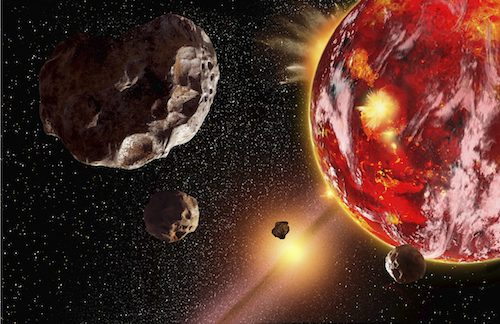
On that fateful Icelandic tour, Meech saw geothermal areas with gas billowing out of the ground. The guide told the group not to worry — it was only water. “Then she said, ‘This is probably primordial water,’ and it set a lightbulb off,” Meech says.
The flavors of water
The source of Earth’s water has been a long-standing mystery; Meech herself has been trying to solve it for at least 20 years. Most of that search has focused on sorting out the various isotopes of hydrogen that go into making the water — or “the flavor of water,” as Lydia Hallis of the University of Glasgow calls it. One of those “flavors” is heavy water, a form of water that incorporates deuterium, an isotope of hydrogen whose nucleus contains one proton and one neutron. Normal hydrogen lacks a neutron, so water with deuterium weighs more than ordinary water.
By simulating conditions in the early solar system, researchers can calculate the ratio of heavy water to ordinary water when the planets were forming. On Earth, the observed ratio is higher than it would have been in the young solar system, leading many astronomers to suspect that the water was imported because the ratio should remain constant over time. Today, most scientists believe asteroids carried water to the young, dry Earth.
Meech was suspicious of this idea because measurements of Earth’s deuterium-to-hydrogen (D/H) ratio, which is connected to the ratio of heavy water to normal, is generally based on the composition of today’s oceans. Reservoirs with a high quantity of heavy water have a high D/H ratio, while deuterium-poor reservoirs show a lower ratio.
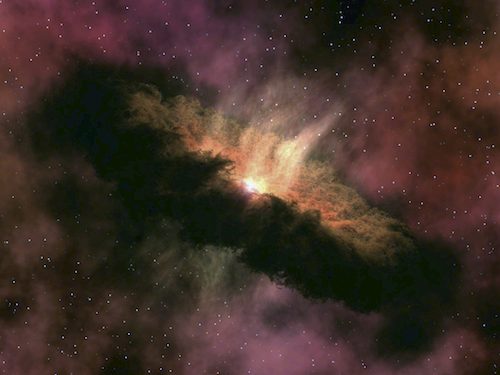
Earth formed from the dust and gas of the nebula that surrounded our infant Sun. This artist’s concept shows the protoplanetary disk of material around a young star. The disk contains the individual components of water — hydrogen and oxygen — and water in both ice and vapor forms. N.A.S.A/JPL-Caltech But Earth’s ratio should have changed over time. Like most planets, Earth probably lost some of its atmosphere to space, and the lighter hydrogen would be easier to strip from the planet than its heavier counterpart. Geological processes, such as the evaporation of water from reservoirs such as lakes and oceans, can also change the ratio, as can biological reactions, because lighter isotopes are used differently than heavier ones in metabolic processes. All of these processes would give the modern Earth a higher D/H ratio compared with when the planet was newly formed.
When Meech heard that primordial water could be spouting from the surface in Iceland, she grew excited at the chance to study the earliest flavor of water. But after chatting with a geologist, she learned that the plumes actually came from more recent activity — they weren’t primordial after all. However, the geologist revealed that some rocky material brought up from Earth’s mantle does contain small traces of water. That material may never have mixed with the stuff on the surface and could represent Earth’s early water. No one had investigated the D/H ratio in those samples because the technology to do so was new. But the University of Hawaii, where Meech is based, had just purchased a new ion microprobe that might be able to do the job.
“I thought, wow, here’s a way we can actually measure the original fingerprints,” Meech says. “At that point, I got very excited.”
In search of the culprit
Earth and the rest of the planets formed inside a nest of gas left over from the birth of the Sun. This material, known as the solar nebula, contained all the elements that built the planets, and the compositions varied with distance from the Sun. The region near the star was too warm for some material to coalesce as ices, which instead formed in the outer part of the solar system. Around Earth, hydrogen and other elements could stick around only as a gas. Because the nebula was short-lived, most scientists suspect that Earth didn’t have enough time to collect these gases before they escaped into space. That idea, along with the planet’s high D/H ratio, led many to believe that Earth’s water must have arrived after Earth had cooled.
When the European Giotto spacecraft visited Halley’s Comet in 1986, researchers noticed its heavy water content was higher than the gas in Earth’s part of the early solar system. A new theory emerged: Comets could have carried water to early Earth. After the planets formed, the enormous bodies would continue to stir things up, with giant planets like Jupiter hurling some material toward the inner solar system. Icy objects that formed in the outer solar system could have been tossed at Earth to rain down as giant water-laden impacts.
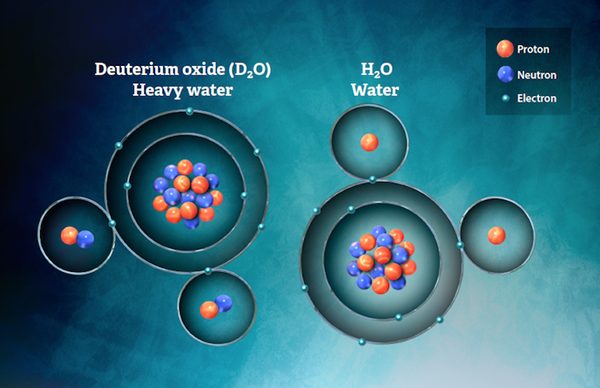
Heavy water, or D2O, contains deuterium in place of hydrogen. Deuterium is an isotope of hydrogen whose nucleus contains one proton and one neutron, whereas normal hydrogen contains only a proton. The ratio of heavy water to normal water in a sample gives scientists information about how it formed — information researchers are now using to try to unravel the origin of Earth’s water. Astronomy: Roen Kelly But as other missions probed more comets, it became clear that the amount of heavy water wasn’t consistent among them. In fact, most of the comets’ heavy water ratios were far too high to be responsible for dropping water on Earth. Another culprit must be responsible.
Comets weren’t the only thing that the gas giants tossed around. As Jupiter plowed through the asteroid belt early in our solar system’s history, it scattered the rocky debris in all directions. Like comets, some of the material rained down on Earth. Unlike comets, asteroids don’t lock up water as ice. Instead, they trap its components — hydrogen and oxygen — inside minerals. Also, the heavy water content in asteroids falls much closer to Earth’s current ratio. That’s why asteroids are the leading suspect for the source of our planet’s water.
“Really, we’re not talking about water; we’re talking about hydrogen,” says Anne Peslier, a geochemist at N.A.S.A’s Johnson Space Center. Peslier studies the geochemistry of Earth’s mantle and the other terrestrial planets, including the hydrogen trapped within minerals.
When Earth formed, the hydrogen surrounding the growing planet was captured in its rocks and minerals. When hydrogen-rich and oxygen-rich minerals melt because of the mantle’s heat, the resulting water can spew from the planet’s crust.
Most of the mantle is rocky, and enormous quantities of hydrogen and oxygen could be trapped inside. Researchers estimate that as much as 10 oceans of water may exist within the mantle.

Astronomers once thought comets, such as Halley’s Comet (top), could be the source of Earth’s water. But the amount of heavy water (D2O) these icy bodies carry doesn’t match the amount found on Earth. Researchers then turned to water-rich asteroids, such as the one in this artist’s impression (bottom), as a more likely source of water.
From top: N.A.S.A; Mark A. Garlick, space-art.co.uk, University of Warwick Erupting volcanoes usually bring up magma from the upper part of Earth’s mantle, the region closer to the surface. This material is more likely to be polluted by hydrogen from the crust, which contains the same higher D/H ratios measured in the oceans today. More pristine samples lie much farther down in the mantle. Although it’s hot there, less than 20 percent of the mantle rock has melted, Peslier says. When the melted material erupts, it can have a violent effect on the solid rock.
“If [the lavas] go fast enough and brutally enough, they sometimes break off pieces of what they are traversing along the way,” Peslier says. She describes the result — called mantle xenolith, after the Greek word for “foreign rock” — as crystals of bright green olivine and black pyroxene embedded in the black lava.
If the hydrogen-rich olivine crystals were captured early enough during Earth’s formation and remained undisturbed for the planet’s 4.5 billion-year lifetime, they could reveal how much the ancient ratios of heavy and normal water shifted, if they changed at all. The tiny time capsules could provide answers to the long-standing questions regarding the source of Earth’s water.
But first, they had to be found.
Hunting primordial water
While Meech knows a great deal about water in the solar system, she wasn’t as familiar with rocks on Earth. She pulled in Hallis, then a postdoctoral student, to lead geological excavations in a hunt for those early fingerprints of normal and heavy water. Hallis was intrigued by the chance to scramble across craters in Hawaii and along the shores of Baffin Island in Canada in search of clues. Baffin is one of the few places where Earth’s deep mantle is accessible. The chain of eruptions that formed the island also created Greenland and Iceland. “The Baffin Island samples are the most pristine examples that we have of the deep mantle,” Hallis says.
Hallis also received samples collected by Don Francis, now an emeritus professor at McGill University in Montreal, from a tiny uninhabited island called Padloping, off the eastern coast of Canada and northwest of Baffin Island. According to Hallis, Francis collected the first of his samples in 1985. The isolation of Padloping Island meant that researchers had to travel there by boat and set up camp. The sheer cliffs made falling rocks plentiful, and Francis picked up the best-looking minerals from the beach. A return trip in 2004 netted even more samples. “Something I would really like to do is go back [to Padloping Island],” Hallis says. The imposing cliffs make it challenging to collect samples, but if she could obtain some from the steep overhangs, she would be able to pinpoint where and when the material rose to the surface.
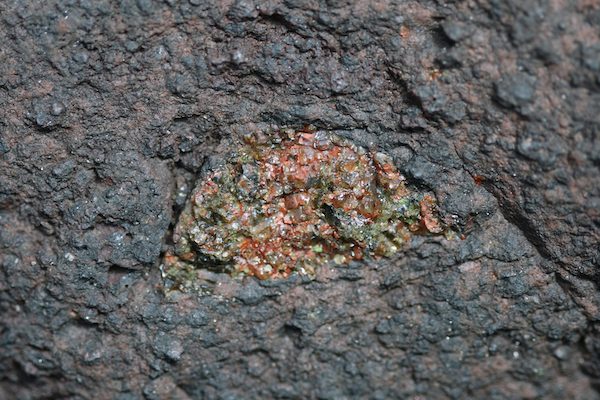
Green olivine crystals in lava can contain and protect hydrogen collected during Earth’s formation, allowing researchers to determine its ratio of deuterium to hydrogen. S. Rae/Flickr With the well-preserved samples in hand, Hallis and her colleagues began to systematically destroy them. The rocks were ground up into sandlike powder. Using the microprobe, the scientists sorted the enclosed crystals by color.
Meech helped to categorize the crystals. “I found it hard to manipulate the tiny little bits of sand without spilling them on the floor,” she admits ruefully.
Part of the process involved ensuring the samples were stripped from the mantle rather than the crust as the volcanic plume burst upward. Previous studies of the Baffin Island minerals suggested that they came from the mantle’s depths, and mineralogical evidence revealed that the samples Hallis had in the lab were most likely pristine. The tiny glass beads were protected in part by olivine crystals, which act as a barrier to prevent weathering once the rocks are on the surface. Even so, they weren’t entirely perfect.
“Even with the most pristine samples that we have, it’s not 100 percent exactly deep mantle,” Hallis says. “It’s always going to have some incorporation of the [upper] mantle in there, just because it has to travel through so much of the mantle to get to the surface.”
While the Baffin Island samples were free of crust pollution, the team wasn’t so fortunate with the rocks gathered near their university. The Hawaiian minerals had suffered from weathering and had been heavily affected by surface water, most likely rain. The pollution kept these samples from revealing the flavors of pristine water.
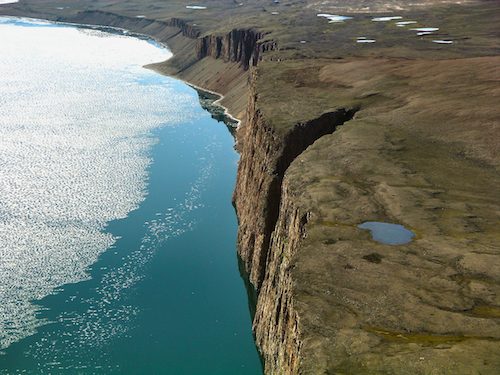
The cliffs near Baffin Island, Canada, grant researchers access to material from Earth’s deep mantle, which may contain the fingerprints of our planet’s earliest water. Timkal/Wikimedia Commons With the first fingerprints of Earth’s water finally taken, Meech and Hallis began to compare them with other samples. Hallis expected to observe a heavy water content closer to the meteorites thought to have delivered water to the young planet. Instead, the samples weighed in with about 25 percent less heavy water compared with normal water — far less than expected.
“That was a bit of a surprise,” Hallis says. “It suggests that carbonaceous chondrites [a class of meteorites] are not a good fit for the source of Earth’s water.” While meteorites may have provided some of Earth’s water, she doesn’t think that they delivered all of it. The source of Earth’s water
What do the samples suggest is the source of Earth’s water? Hallis suspects it came from the solar nebula. While many scientists argue that the nebula would have dissipated within 6 million years — long before our planet could have grown large enough to capture it — she points out that several young stars have been found with gas around them for as long as 10 million years. That would give the tiny rocks that ultimately built Earth enough time to incorporate elements like hydrogen and nitrogen into their structure. Hallis says nitrogen and hydrogen in the solar system tend to follow one another — “If you have a certain flavor of hydrogen, you have a certain flavor of nitrogen,” she says.
“Perhaps you still have pockets in the Earth that have preserved this initial hydrogen source,” says Zachary Sharp, a researcher at the University of New Mexico who also suspects that Earth’s D/H ratio has shifted over time.
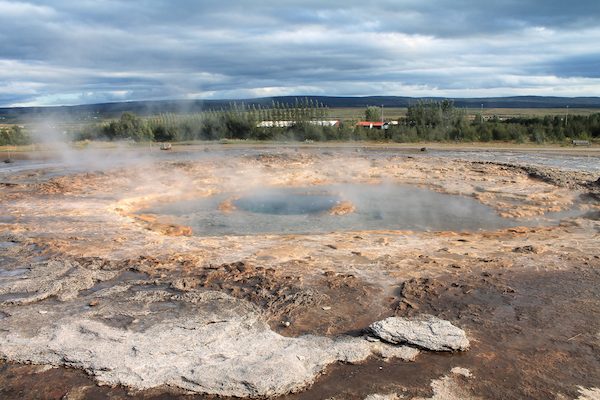
Geysers such as Strokkur in Iceland inspired Karen Meech to hunt for Earth’s primordial water. Although such geysers do not spew the unaltered early water needed to pursue this line of study, other geological processes, such as volcanic plumes, do. Ivan Sabljak/Wikimedia Commons Hallis’ results aren’t the only ones to suggest that Earth may have picked up the bulk of its water from the start. While the Moon was once thought to be completely dry, recent re-examinations of Apollo Moon rocks have revealed traces of water. The leading theory for the Moon’s formation is that it was created when a Mars-sized object slammed into the young Earth. Liquid water on the surface would have been vaporized, leading many to conclude that Earth had to pick up more water from elsewhere. But the low D/H ratios from the lunar samples suggest that the Moon could have collected the water in minerals locked in its interior, a region neither comets nor asteroids could have polluted. Later volcanic eruptions hurled that material to the surface, to be returned to Earth by astronauts.
Why is this important? The high temperatures post-collision would have been similar to those found in the solar nebula, Hallis says. That helps to make the case that even in the hot early solar system, volatiles and water could be accreted.
But hydrogen comes in heavy and light flavors, so doesn’t that mean the ratio could change in either direction? Not really, according to Sharp, who has revisited the idea that most of Earth’s water may have been collected from the nebula rather than later collisions. “It’s easy to increase the isotopic ratio of the samples, but it’s difficult to lower them,” he says. That’s because the lighter hydrogen is easier to remove. For instance, hydrogen rises more easily to the top of the atmosphere, where the solar wind can strip it away. The heavier deuterium tends to stay closer to the ground.
Asteroids are also providing hints that Earth’s water may have come from the gas that birthed the planets. Studies of meteorites from the large asteroid Vesta have revealed ratios of heavy water similar to the Baffin Island estimates.
“Now that we are finding low values in Earth, the Moon, and Vesta, and also in the water reservoir of the asteroids, now maybe the [nebula] story is possible,” says Alice Stephant of Arizona State University, who studies Vesta. “It seems like they all share a common reservoir that is lower [in deuterium] than what we thought.”

Padloping Island is isolated, uninhabited, and home to what may be some of Earth’s oldest rock. Future expeditions to this island in Canada may confirm preliminary findings that our Sun’s protoplanetary nebula may have stuck around long enough for a forming Earth to capture hydrogen — a building block of water.
Doc Searls/Flickr The smoking gun
The lower D/H ratios revealed by Hallis, Meech, and their colleagues are not yet widely accepted. Conel Alexander, a cosmo-chemist at the Carnegie Institution of Washington, says there are two reasons why other researchers didn’t immediately change their minds about the source of Earth’s water.
One argument against the results stems from how Hallis extrapolated the isotopes and elemental abundances in her measurements; Alexander says some scientists disagree with how the final numbers play out using her method. The other issue is how Hallis explained her results. “Lydia’s interpretation was unique,” Alexander says. “There may be other ways of getting hydrogen into the melt inclusions that she was measuring.”
Alexander’s chief concern stems from the fact that only a single source of rocks — the Baffin Island samples — was used to estimate the entire planet’s ancient ratios. “The bulk of Earth may have a completely different composition, and there may be something weird about ocean islands’ basalts,” he says. He hopes that other scientists will follow Hallis’ lead and measure the D/H ratio from a variety of deep-mantle plumes.
Hallis is ready to take her own trip to Padloping Island to collect more samples. One thing she would like to do is investigate not just the hydrogen involved, but also the nitrogen. But analyzing the nitrogen in samples is more difficult than hunting down hydrogen, partly because there is even less nitrogen in these samples than hydrogen. Measuring nitrogen also requires instruments capable of very high precision. Hallis says it’s pushing the limit of what current technology can do.
Alexander says that Hallis’ goal of hunting down nitrogen from future samples will also help firm up any doubts about the primordial nature of the Baffin Island samples. “If she can show that there is both light hydrogen and light nitrogen in these inclusions, I think that would be a smoking gun,” he says. “If the nitrogen follows the hydrogen, then we proved our theory that [the samples] are primitive,” Hallis says.








